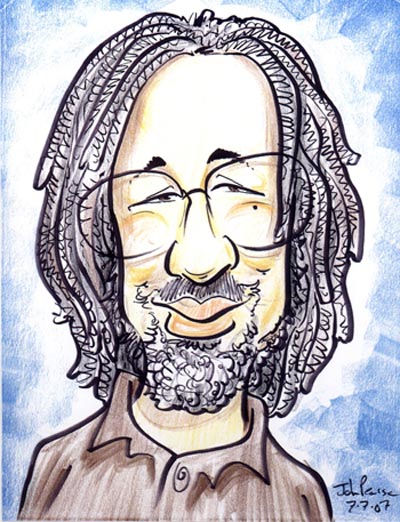
Columns written for the Berkeley Daily Planet newspaper, Berkeley, CA
Berkeley Daily Planet
Portrait by John W. Pearson
www.johnwpearson.com

Columns written for the Berkeley Daily Planet newspaper, Berkeley, CA Portrait by John W. Pearson |
|
|
JUDGING MR. DELLUMS
Or maybe not. Some of Mr. Dellums’ critics—NovoMetro’s Echa Schneider (VSmoothe) comes quickest to mind—study the data and present detailed policy analyses to back up their positions. I rarely agree with Ms. Schneider/Smoothe’s conclusions, but I admire and respect the work she puts in, and learn a lot of things from the data she collects. That’s responsible criticism. But others—they shall remain nameless for now, but I’ll call out their names if they keep it up—seem to believe that because they do not actually see the mayor “doing” things during the course of the day, it must be proof that nothing is being done. Thus did the men sitting at the corner table in the bar prove conclusively that air does not exist, since, after all, it has never been seen. Evaluating mayoral work styles—as opposed to policy initiatives or results—is made difficult in Oakland because we are still new to this full-time mayor thing. Up until the Jerry Brown era, mayors in Oakland served on City Council, where their involvement and political positions were easy to judge. Under the strong-mayor initiative that immediately preceded the inauguration of Mr. Brown, the mayor was removed from the Council and, for all intents and purposes, from public sight. That initiative gave broad guidelines as to the mayor’s responsibilities, but little or no guidelines as to how the mayor should carry them out. And there is no record in the possession of the City of Oakland of the day-to-day activities of the Brown Administration, those records never having been turned over to the City Clerk by Mr. Brown on his way out the door, as they were supposed to have been. And although Council President Ignacio De La Fuente famously proclaimed during the 2006 campaign that he would be a “24/7” mayor if elected, a standard by which some people have judged Mr. Dellums, we have no way to know how, exactly, Mr. De La Fuente himself would have carried out that pledge if it had been he who Oakland elected instead. That has left us with insufficient evidence in order to judge Mr. Dellums’ day-to-day activities or his style of governance, as opposed to judging his policy initiatives or his results. But clues are slowly emerging, for those who wish to look. During his eight years in office, Jerry Brown called upon the city bureaucracy to carry out certain initiatives. Most famously, he mobilized the office of then-City Administrator Robert Bobb to promote Mr. Brown’s two charter school proposals. For weeks during the beginning of the Brown Administration, Mr. Bobb and several staff members trotted from meeting to meeting, week after week, between the city, county, and local school boards to try to win board sponsorship charters, and after Brown’s charter Oakland Military Institute opened up shop at the Army Base, assistant administrator Simón Bryce moved his office to the facility and spent considerable time working on charter business. Mr. Brown later fired Mr. Bobb and replaced him with current City Administrator Deborah Edgerly, reportedly because Mr. Bobb favored a uptown ballpark for the Oakland A’s over Mr. Brown’s uptown development proposal, a proposal that eventually became the Forest City project. But even while replacing Mr. Bobb with Ms. Edgerly, Mr. Brown appeared to leave the day-to-day workings of the city bureaucracy alone, so that the bureaucracy continued to operate much as it had under the old Council-City Manager form of government. Mr. Dellums has taken a decidedly different tack. He has pointedly stayed out of City Council business policy-making business, declaring that the mayor’s job is to run the city, and that the city staff—the entire city staff, not just his own personal staff—was the vehicle in which he intended to get that done. In one of the most important, but little noted, passages in his recent State of the City address, the mayor declared that “I have changed the culture at City Hall and joined the mayor’s office with city administration. It’s no longer the mayor over here and the City Administrator over there.” Insiders familiar with the Dellums Administration say that the mayor has spent considerable time with top city administrative officials, trying to put together an executive team that functions together on the administration’s policy goals. How well has that been working? The mayor’s recent victories in Council in passing his police augmentation plan and his industrial zoning policy provide some insight, but there are serious budget and policy battles left ahead, and so the jury is still out. Another difficulty in analyzing the Dellums Administration is that unlike most politicians, Mr. Dellums feels that the secret to winning policy battles or getting resources for the city is to spread the credit around, rather than trying to take all or most of it for himself. Thus at a recent Oakland High School press conference to announce a joint city-county-school district-Kaiser Permanente initiative to put five public health clinics in Oakland high schools and middle schools in the next two years, Mr. Dellums decidedly downplayed his own involvement in bringing the process together, saying only that it was an “extraordinary day that typifies the type of collaboration we want with public and private entities.” It took Kaiser representative Bernard Tyson to reveal to the press that it was Mr. Dellums who kickstarted the process that led, eventually, to a $3 million Kaiser donation to help move the health clinic initiative forward. Mr. Tyson said that Kaiser had been talking about funding some sort of health activity in Oakland, but had put those plans aside until Mr. Dellums asked Mr. Tyson to set up a meeting with Kaiser officials to talk over public health care concerns. “I thought we were going to meet in the mayor’s office,” Mr. Tyson said. “Instead, he came over to my office at Kaiser to talk with several of us for a few hours. We were surprised to see how many of our plans and interests overlapped with his.” The school health clinic initiative is probably the best clue as to how Mr. Dellums operates, cobbling together smaller, ongoing initiatives into a larger, more productive one while letting the original operations get the lion’s share of the credit. In this case, Alameda County officials had money to operate the clinics once they are built, but no money to build them. The Oakland Unified School District has money under its facilities bond to turn existing school facilities into health clinic sites—the Oakland High clinic will be housed in an old shop class—but no money to operate them. Kaiser had money to help the process get started. Mr. Dellums helped bring them together and got the beginning of the school-based health clinics that are a major part of his model city program.. In reporting on the Oakland High press conference, for example, CBS5 television station headlined its story with “Kaiser Provides $3 Million Grant For School Health Centers,” the first paragraph of the story noting that “Kaiser Permanente announced today it is providing a $3 million grant to fund school-based health centers at one middle school and four high schools in Oakland to provide comprehensive clinical and social services to children.” Mr. Dellums was mentioned, but only after Kaiser got its props, and with no mention of the mayor’s role in putting the entire initiative together. Another key to understanding Mr. Dellums’ day-to-day involvement in his administration and policy initiatives is listening to him speak. So where does that leave us in judging the success or failure of the Dellums Administration? Right where it ought to be, in that constant tension between what has been promised, and what is being fulfilled. In that regard, there is more than enough solid information to work with, without having to resort to the silly and superfluous. |